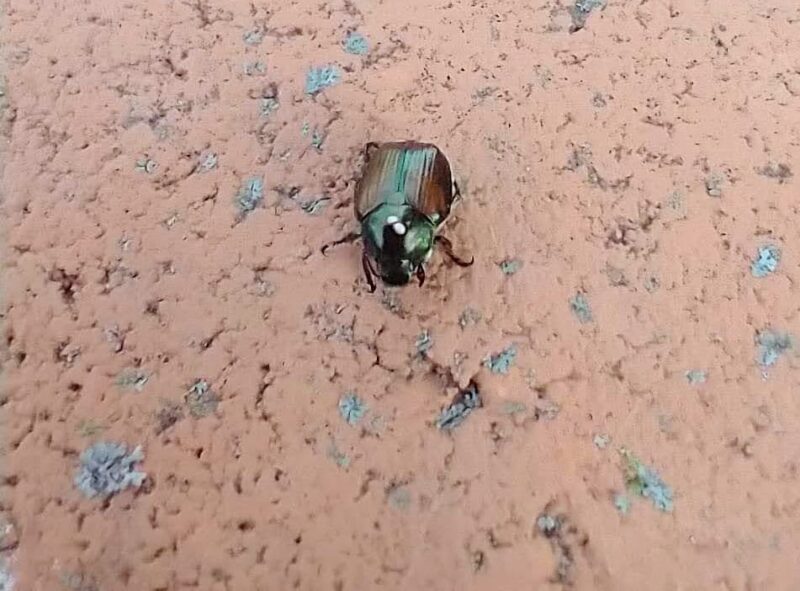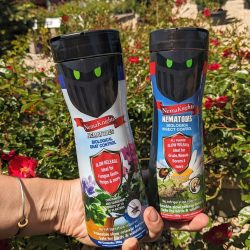
Minimize Japanese Beetle Damage

Japanese Beetles are serious pests in both the adult and the larval grub stages.
The adult beetles are above ground, feeding, mating and laying eggs from mid-June to early August. The white ‘C’ shaped grubs spend the rest of the growing season eating the roots under your lawn.
If you do notice leaves that look like green lace, that’s a sign you have Japanese Beetles in your yard. Luckily healthy trees and shrubs will survive these feedings. Focus your mitigation efforts on immature or heavily damaged plants as well as fruits, vegetables and herbs first. These immature plants can tolerate some leaf feeding but severe damage may affect plant growth and reduce yield.
Grub Identifier
C-shaped, white to cream-colored grubs with a distinct tan-colored head. They will be 1/8th inch up to 1 inch long. Japanese Beetle grubs look like other white grubs and can be distinguished by the hairs on the end of their body.
Photo courtesy : UMN Extension
Methods to Minimize Japanese Beetle Damage
Start managing their population right when you start seeing leaf damage. The adult beetles will be feeding up to 8 weeks starting around mid-June.
Cultural Control Methods
Incorporate plants around your favorite landscape and garden plants that repel Japanese beetles such as catnip, chives, garlic, odorless marigold, nasturtium, and white geranium.
Natural predators to the beetle are birds, spiders, and possibly raccoons, moles, and skunks. The Starling bird is it’s greatest predator. Create a yard that attracts these predators so they can help you with minimizing damage and the beetle population.

Physical Removal
Browse your garden daily, focusing on the plants they are attracted to or the ones you want to minimize damage. Hold a small bucket of soapy water under the beetle and tap or shake the critter into it. You may have to grab them instead if they are flying away.
They naturally fall to the ground as a defense mechanism and easily get lost in the soil. Visit your plants as often as possible and inspect carefully.
Since they are attracted to the scent of other Japanese Beetles, do not squish them!
Netting Your Plants
If a tree or shrub is no longer in bloom, you can use a fine mesh barrier to cover the plant. If the plant is blooming and needs to be pollinated, hand-picking is going to be the only option. You don’t want to spray insecticides on your plant at that time.
Japanese Beetle Traps
If you can place traps far away from gardens and landscape plants, this can help populations migrate away from valuable landscape plants. Keep in mind, they can fly 10-15 miles to a new place to feed and you may just be attracting them to your area. Do not place the traps near your favorite trees and garden. The USDA recommends putting them at the border of your property and throughout the community.
Biological Controls
“Two natural enemies of Japanese beetles have been released in Minnesota. The fly Istocheta aldrichi lays eggs on adult Japanese beetles in summer, whereas the wasp Tiphia vernalis parasitizes grubs in the spring. Although both natural enemies became established here, neither is very abundant and they have little impact on Japanese beetle populations.” – UMN Extension
To focus on killing the grubs, start treating yards and gardens with grub killers in early July. Killing grubs under the lawn this summer will not affect the number of beetles this year, but next year the number of beetles that emerge from your lawn should be reduced. Killing grubs will reduce damage to your turf but adjacent properties may still have Japanese Beetles so you may not see reduction of adult beetles.
Bt
Bacillus thuringiensis galleriae is another natural way to kill the grubs. Bt is a naturally occurring soil bacteria that eats Japanese Beetle grubs before they can develop into beetles. It can last up to one to two weeks and it is not harmful to bees.
Milky Spore
Milky Spore is a biological agent that is specific to Japanese Beetle grubs and will not harm other grubs. It also does not harm earthworms, and other insects such as bees and butterflies, pets, humans or other animals. It does need one or more applications annually for three to five years to adequately inoculate your lawn, but once appropriate levels are in place, no further treatment is needed for 10 years.
Nematodes
Nematode biological insect control is 100% pesticide free, organic, and pet friendly for indoor houseplants as well as gardens.
In the spring, if you notice unexplained small patches of dead brown grass, you can dig up part of the area and you may find the culprits. Grubs! These areas can be spot treated with nematodes to control the grub population that will eventually go into their adult phase and hatch out of the ground.
Another option is to treat around plants that you know have been attacked by Japanese Beetles, Weevils, or Borers in late spring/early summer while the adults are active. Early fall, while the grubs are young, is another good time treat young grubs while they are moving around the soil and finding a place deeper in the soil before winter hits.
Japanese Beetle Insecticides
It’s the law to read and use insecticide according to the label and apply only as recommended. Make sure that it can be used around the plants you wish to treat and for the insects you want to control. We recommend avoiding insecticides when possible.
Systemic
A granular or liquid Systemic Insecticide containing Imidacloprid and dinotefuran, both neonicotinoids, can be applied to lawn one time per year. This seems like an easy way to minimize damage but these are highly toxic to all pollinators. The plant roots absorb the insecticide and will poison the beetles and any insects that munch on the plant. Apply when the plant is not in bloom to prevent pollinator death and 4-5 feet away from flowering plants.
Topical
Topical insecticides, like Eight, which contains Permethrin (high toxicity to fish and bees), can be sprayed on vegetables, fruits, flowers, nuts, lawns, and outside surfaces of buildings. Neem oil is an organic and less toxic insecticide that is an alternative. If you are spraying edible plants, be sure the product is labeled for those plants. Be aware, however, that these are ‘broad-spectrum’ insecticides that affect many kind of insects, including bees and butterflies, so use them cautiously, applying only when and where needed. Keep these insecticides away from ponds and streams as well.
Professional Application of Insecticides
There are insecticides that can only be applied by professionals, like chlorantraniliprole, that have a lower risk to harm other beneficial insects.
Image source: Proven Winners
Here is another great resource from the USDA on Japanese Beetles, their life cycle, plants that are not susceptible to damage and ones that are, and much more! USDA Japanese Beetle Handbook (pdf)
Please let us know your questions or if you need help fighting off these buggers! We have many products in store to help minimize Japanese Beetle damage so come on in and we will fight this battle together.


